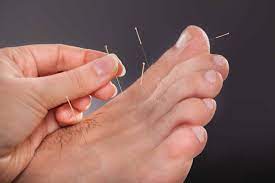There might be taut bands throughout your body, which can interfere with the blood flow to your muscles. It’s possible for the afflicted region to develop an acidic environment, which would then cause discomfort to spread to other areas of the body. When those taut bands start to transfer pain elsewhere, that’s when you have a trigger point. This type of pain, whether local or referred, can be helped by a method called dry needling.
Dry needling is a method of skilful intervention that involves penetrating the skin with a small needle with a filiform tip to release underlying myofascial trigger points, as well as muscle and connective tissues. It can assist in the management of neuromusculoskeletal discomfort as well as limitations in mobility. A wide range of conditions, from headaches and migraines to low back pain, can be treated effectively with dry needling. This helpful method may also be used to treat plantar fasciitis, which can be a painful condition. Athletes that compete for long periods frequently suffer from this illness.
Referred Pain – Inflammation or Trigger Points?
Plantar fasciitis is an inflammation that affects the band of tissue that runs down the bottom of the foot and the arch of the foot. Illustration may be the source of the discomfort; nevertheless, the trigger points in the Gastrocnemius and Soleus muscles are frequently the real culprits (aka calf muscles). Plantar fasciitis is a condition affecting the plantar fascia, which runs down the bottom of the foot from the heel to the toes. It can also cause discomfort in the arch of the foot. Individuals who suffer from plantar fasciitis, especially endurance athletes, may have pain while walking for the first time in the morning, after sitting for an extended period, or after walking or standing for an extended period, particularly when barefoot.
The Influence of Dry Needling on the Central Nervous System
Dry needling of trigger points is a technique that, in addition to reducing trigger points in the muscle, is known to activate brain pathways to block pain. This is accomplished by interrupting pain impulses transmitted to the central nervous system. This indicates that dry needling might not only be a band-aid solution for your plantar fasciitis in the short run. The feeling of relief may linger for several days. Dry needling for plantar fasciitis, in conjunction with other physical therapy treatments, may alleviate heel discomfort.
The Studies
According to the findings of one study, trigger point dry needling had a beneficial effect on patients suffering from plantar heel discomfort that is caused by musculoskeletal issues. Another study revealed that dry needling of trigger points can successfully alleviate pain and is an excellent alternative to explore before performing treatments or procedures that are more intrusive. According to the findings of additional investigations, trigger point dry needling can potentially alleviate pain and symptoms more rapidly than conventional treatment approaches.

